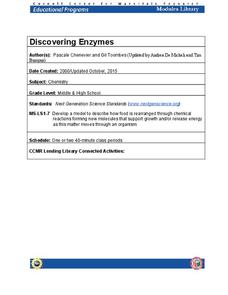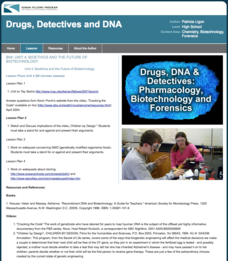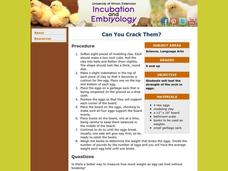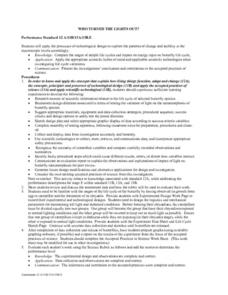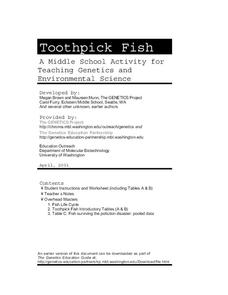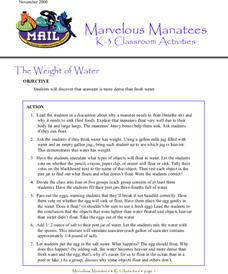Curated OER
Friends on the Farm
Young farmers explore the world of farm animals. They are introduced to a variety of animals, what their role is, how many legs they have, and what sounds they make. Worksheets and websites embedded in the plan are used to carry it out....
Curated OER
Human Genetics Lesson
Youngsters are assigned the task of interviewing a family member or a neighbor and asking them about any genetic disorders that are present in their family history. They pretend that they are about to have a baby that is carrying a...
Cornell University
Discovering Enzymes
Explore the function of enzymes through a series of lab investigations. Learners use household enzymes such as hydrogen peroxide to model the role of enzymes. The enzymes break down proteins with and without a catalyst.
Centers for Disease Control and Prevention
Understanding the Epidemiologic Triangle through Infectious Disease
Introduce infectious diseases and the epidemiologic triangle. A helpful resource describes the agent, host, and environment from the three vertices as well as the time factor, which is in the middle. Scholars complete a simple...
Kenan Fellows
Unit 4: Bioethics and the Future of Biotechnology
What's the future of biotechnology? Explore a hot topic in the fourth and final unit in a series of Biotechnology lessons. Learners develop an understanding of the many issues in bioethics, then create an argument for or against the role...
Curated OER
Fossil Find
Students investigate the practice of digging for fossils. They participate in a mock dig of fossils using real bones and other artifacts. Then students dig through sand in order to go through the simulation. Students make observations...
American Museum of Natural History
All About Cloning
Start seeing double. The American Museum of Natural History website provides pupils with information about Dolly, the cloned sheep. Learners find out the procedure used to create Dolly along with why scientists clone animals.
Curated OER
Can You Crack Them?
Students test the strength of the arch in eggs. Then form hypothesis for how to increase their strength.
Curated OER
Who Turned the Lights Out?
Learners discover the life cycle of butterfly by observing its growth from egg to caterpillar and the formation of its chrysalis. Students conduct an experiment in which they design housing for the chrysalises which are either in full...
Curated OER
Water Quality and Temperature
Learners are led through three activities to explore the effect of temperature fluctuations on the growth and survival of aquatic plants, clams, and shrimp eggs.
Curated OER
Simple Machines
Fourth graders examine a machine and how its parts work together. In this simple machines lesson, 4th graders work in groups to study different gadgets, analyze how the parts of the gadget work and draw sketches of the gadget. Students...
Curated OER
Pond Life
Students recognize the habitats of animals that live near or in a pond. In this pond lesson, students examine pond water and look for pond organisms. Students observe organisms with a loupe and complete a worksheet.
University of Washington
Toothpick Fish
With colored toothpicks representing genes, youngsters practice passing them through generations of fish and learn about heredity. Consider this as an introductory activity since it does not represent recessive genes with lowercase...
Curated OER
In the Company of Wild Butterflies
Learners discover the life cycle of a butterfly and explain the different stages. In this exploratory lesson students watch a video and create insect art and they will get an opportunity to view live specimens of butterflies.
Curated OER
Garbage in the Garden
Students create their own compost. In this soil lesson, students fill a bag with waste and soil, in order to create a mini compost bin. Students observe the baggies over a 6 week period, they record their findings and collect data...
Curated OER
Inviting Butterflies to the Schoolyard
Learners create a butterfly garden. In this butterfly garden lesson, students plot a garden with plant species that will attract butterflies. Learners learn about the specific plants and items that will help butterflies use the garden.
Curated OER
Crickets on the Hearth
Learners investigate how crickets behave in cold temperatures. In this life science instructional activity, students explain the beneficial and harmful effect of pests. They research ways to properly manage them.
Curated OER
The Brine Shrimp Project
Tenth graders design and conduct a laboratory investigation to determine how different factors may affect the hatching and development of brine shrimp eggs.
Curated OER
The Weight of Water
Students participate in an experiment about the weight of water. They work together to discover that seawater is more dense than fresh water. They also determine which objects float and sink.
Curated OER
Rocks Are Different Colors
Students examine different rocks and find the many different colors in each and then compare these rocks with other rocks. Then they look at their rock collection and tell me the colors they see. Students also put each rock in the bowl...
Curated OER
Venom!
Students examine the nature of venom. They conduct an experiment to demonstrate how proteins such as venoms can be denatured using raw eggs, beakers, heated water, and compresses.
Curated OER
Have You Ever Wondered?
Students use their personal knowledge and the Internet to discover where and how spiders live. In groups, they discuss their experiences with spiders and how their lives differ from other insects. They use new vocabulary to discuss their...
Curated OER
Rock Sorting
First graders observe rocks, record their observations about the rocks and classify them according to their observations. As a class, 1st graders create a list of observable characteristics of rocks. They sort a group of rocks...
Curated OER
Is Dilution the Solution to Pollution?
Students explore the different types of pollution. they conduct experiments using dye mixed with tap water to measure the levels of dilution. They discuss at what point the dye (pollution) would be diluted enough to be safe to drink.




